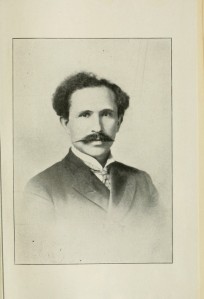Archive for the ‘illustrations’ Category
Songs of the Diaspora (part two)
Back in August I was definitely fooling myself, thinking I could write about Yiddish poetry while trying to pack an apartment — and without sustained access to a library. Now I am probably fooling myself again, thinking I can pick up where I left off . It’s tempting, in fact, to say, “the hell with it”; “let it all hang.” This blog was meant to be a record of distraction. When distraction becomes obligation, it’s time to play hooky, right? Hooky from hooky, as it were … or maybe not, since that would mean going back to school.
Anyway, for good reason or bad — or just because — I’ve gone ahead with part two, half a conclusion to my reading of Alice Stone Blackwell’s Songs of Russia (1906), focusing now on the first of the two Yiddish poets.
Part one is here. Part three to follow.
◊
 Since abandoning these notes in August, I’ve acquired Marc Miller’s Representing the Immigrant Experience (2007), a study of Morris Rosenfeld (I’m still looking for good source material on David Edelstadt). Miller’s book doesn’t mention Blackstone’s anthology, so I don’t feel entirely superseded … but I do feel superseded a little. My one consolation: Miller answers a question dogging me while I wrote part one. “Did Rosenfeld write either of his two poems in Russia?” The answer, I now know, is nyet. His earliest poems date from after his arrival in the U.S. (heretofore, the best I’d been able to ascertain was that his first publications came after his arrival, not quite the same thing).
Since abandoning these notes in August, I’ve acquired Marc Miller’s Representing the Immigrant Experience (2007), a study of Morris Rosenfeld (I’m still looking for good source material on David Edelstadt). Miller’s book doesn’t mention Blackstone’s anthology, so I don’t feel entirely superseded … but I do feel superseded a little. My one consolation: Miller answers a question dogging me while I wrote part one. “Did Rosenfeld write either of his two poems in Russia?” The answer, I now know, is nyet. His earliest poems date from after his arrival in the U.S. (heretofore, the best I’d been able to ascertain was that his first publications came after his arrival, not quite the same thing).
Rosenfeld was already in his twenties when he left the Russian empire for good, so it’s not surprising that both of his poems, though written in the U.S., retain a Russian perspective, which certainly invites a reader to see them as Old World creations (and nothing in Blackwell’s anthology suggests otherwise). The first, “The Jewish Soldier,” recalls the 1877 Siege of Plevna; the second, “On Ocean’s Bosom,” concerns the flight of Jews across the Atlantic … but with a twist. This twist — reverse emigration — is not revealed until the 20th and 21st stanzas.
The poem divides roughly into three sections. The first (stanzas 1-9) gives the setup: a ship at sea, in terrible danger from storm (1-4); awful noise from the passengers (5-6); inexplicable calm from two men in steerage (7-9). Next comes the speaker’s questioning of the two men (stanzas 10-14). Finally, after a pause in which the setting is again described (stanza 15), the men explain themselves tearfully (16-24): they are Jews, and though they have nothing to look forward to in Russia, save pogroms, they are leaving America; not of their own free will, as with the speaker, but from poverty.
 There is, perhaps, an autobiographical element in this encounter: Rosenfeld came to America for six months in 1882, returning briefly to Russia before the draft forced him to flee for good. When he made his own reverse voyage, it may well be that he met men like those in the poem. Does it make a difference, then, that he only wrote the poem after reversing his reversal? Only if we take his speaker’s voluntary return to Russia as a sincere preference for the Old World on the part of the poet. A reading of that sort (especially in the context of Songs of Russia ) might well admit an inference of Russian patriotism — an inference turned ironic when we learn more about the poet.
There is, perhaps, an autobiographical element in this encounter: Rosenfeld came to America for six months in 1882, returning briefly to Russia before the draft forced him to flee for good. When he made his own reverse voyage, it may well be that he met men like those in the poem. Does it make a difference, then, that he only wrote the poem after reversing his reversal? Only if we take his speaker’s voluntary return to Russia as a sincere preference for the Old World on the part of the poet. A reading of that sort (especially in the context of Songs of Russia ) might well admit an inference of Russian patriotism — an inference turned ironic when we learn more about the poet.
Ironies notwithstanding, the poem is indeed a song of Russia, also of America. And also, emphatically, of the diaspora: a protest against dispersal, international in its address. A reader’s appreciation of all this requires, however, a little context. Blackwell’s sophisticated readers no doubt brought that context to their reading. But as the book and its historical moment receded into memory (and then out of memory, into the archive), this preparation for understanding became less likely. I take my own rough understanding as typical: I get the general idea, but the fine points escape me. I did not know, for example, that the two Jews are not returning to Russia (as I at first presumed) because they find poverty more threatening than the pogroms. Their departure is involuntary for a more concrete reason. As explained by Abraham J. Karp, “The two Jews were turned back by the March 3, 1891, immigration law which barred entry to ‘paupers or persons likely to become a public charge.’” The poem, then, has complexities, but they’re frangible. Our care for them is a direct function of how much we know. Read the rest of this entry »
A Monster Woe Lies in My Breast
Since the images are so small in the post below, here’s E. M. Lilien’s strange creature in the web, feeding on the heart of the poor:
And here’s a Rosenfeld poem, as rendered by Rose Pastor Stokes and Helena Frank, chosen, of course, for its leeches: Read the rest of this entry »
The Ghetto through a Spiderweb
I’ve been taking notes on Yiddish poetry, as time permits, hampered by limited access to a library — the one near at hand is not, alas, rich in relevant materials — but I’ve managed to find a few useful leads online. As well as a few things that are truly incredible. one of which I thought to share right away: Berthold Feiwel’s German translation of Morris Rosenfeld’s poetry, Lieder des Ghetto (Benjamin Harz Verlag, 1902), which features breathtaking graphic work by E. M. Lilien. Truly, one of the most beautiful books I’ve ever seen, starting with the colophon, which is printed in the shape of a Star of David:

The colophon appears on the verso of the title page, to the left of the following illustration, I guess a combination frontispiece/half title, which shows a drooping, leafless tree twined with barbed wire, holding up a harp with torn stings. An image of despair, though the carved-dove corner of the harp gives an illusion of escape, as it seems to be alighting from the branches, its head poking out from under the gate that reads Songs of the Ghetto:
The book includes a number of other full-page illustrations. I’ll show only a sample. This one opens the section “Lieder der Arbeit” (Songs of Work):
And this one, which makes plainer Lilien’s debts to Jugendstil, opens the section “An der Nähmaschine” (On the Sewing Machine): Read the rest of this entry »


